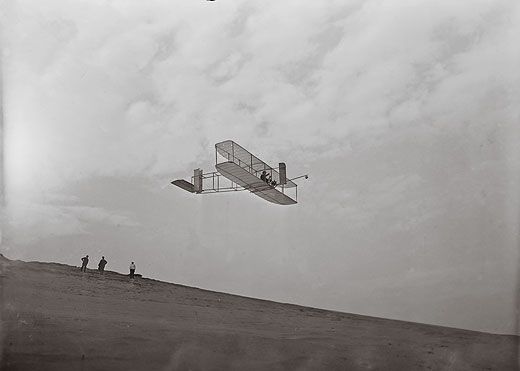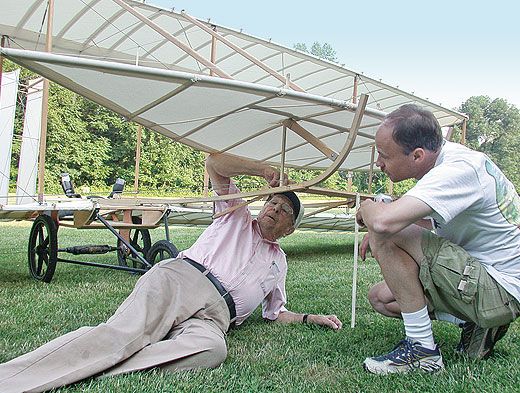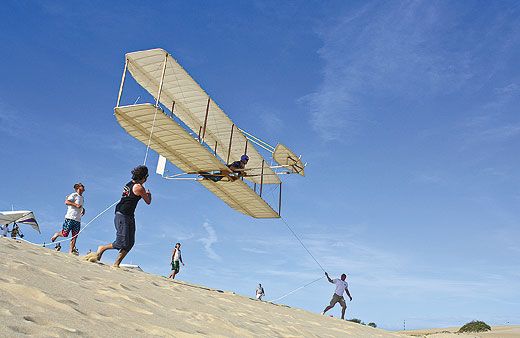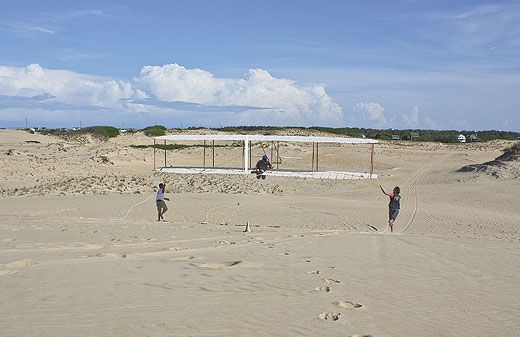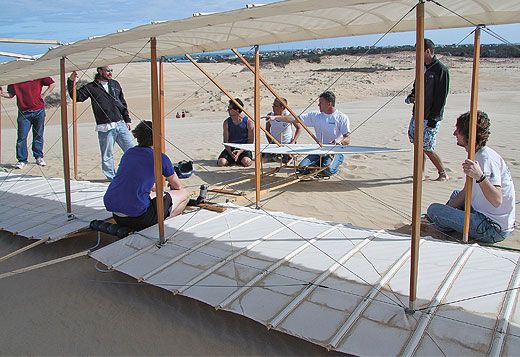Orville, Wilbur and Me
You too can fly a Wright aircraft.
/https://tf-cmsv2-smithsonianmag-media.s3.amazonaws.com/filer/orville-wilbur-aug-2012-5_FLASH.jpg)
The Wright brothers never trudged up these dunes barefoot. Bruce Weaver, Andy Torrington, and I are struggling to carry a glider up a sandy winding trail in Nags Head, North Carolina. A near-exact reproduction of a 1902 Wright aircraft, the glider rests on a four-wheel dolly with balloon tires. Andy is pulling and steering, Bruce is pushing, and I’m trying to keep tree branches from snagging the flexing wings while tip-toeing on hot sand spiked with underbrush. Barefoot is the best way to get up a hill of sand, but as the sun torches the tops of my feet, I start to appreciate the Wrights’ formality. When they conducted their flying experiments a fewmiles north, they wore shoes (not to mention wool suits and ties).
The glider weighs around 120 pounds, but it feels heavier, and it’s bulky—302 square feet of yellowing cotton wings built just like the original: the same ash and spruce frame and weather-beaten, cross-stitched fabric. Constructed in 2003 by The Wright Experience, a group run by renowned Wright scholar/replica builder Ken Hyde, it’s the closest the team could get to the original. Sure, they used multiple twisted wires because the original single-strand hard wire breaks too quickly, and they added a harness rigged to hold you in when you hit the sand. You’re going to hit a lot of sand.
Complete accuracy is impossible: Of the original, only a wingtip bow exists. The brothers famously never left plans, only the patent drawings. (It was the glider, not the powered 1903 Flyer, that first achieved the three-axis control that the brothers patented.) “There are some sketches and notes in their papers, in their notebooks,” Hyde says, adding: “Luckily, the brothers took a lot of good photos.”
Hyde and The Wright Experience built this glider for the Discovery of Flight Foundation, which used it to train pilots for a flight planned in a replica Flyer for December 17, 2003, the 100th anniversary of powered flight. (That attempt failed.) Once the glider had served its mission, the foundation, like the Wright brothers, stashed the craft in a hangar.
Last year Paul Glenshaw, the executive director of the foundation, and his son visited Kitty Hawk Kites Flight School, which offers instruction in a variety of hang-gliders. Glenshaw sat down with the school’s manager, and along with The Wright Experience, they worked out an agreement in which the school would use the replica to teach gliding on the dunes at Jockey’s Ridge State Park. Glenshaw says he wanted people to connect with the Wright brothers’ accomplishment, and Hyde says Kitty Hawk Kites was the right group to show what the glider can do: “They know the winds and they know the weather.”
For $349, Kitty Hawk Kites offers a four-hour flight lesson in the glider, with up to five students per lesson. The company has started with one lesson a week. So far, 35 pilots have flown the Wright glider. (“Pilots” may be a misnomer: No experience in airplanes or gliders is necessary.)
When I first arrived at Jockey’s Ridge, Bruce, the clean-cut recreation manager, and assistant recreation manager Andy took me to the school’s hangar. The glider was up on a rack. “It looks fragile but it takes a beating,” Bruce said. “It flexes, it creaks, but it bounces back into shape. It’s tougher than it looks.”
“How safe is it?” I asked.
“I think it’s very safe,” said Bruce.
Well, no one died in the Wrights’ glider, I thought.
Bruce, Andy, and I made the long haul up Jockey’s Ridge. Andy, a happy guy with long, thinning red hair, was wearing the Kitty Hawk Kites uniform: bare feet, shorts, and a T-shirt.
Up on the Jockey’s Ridge peak, the wheat-color biplane got curious looks from nearby students in starter hang gliders. Bruce and Andy lifted the glider off the dolly and set to work connecting control wires to control surfaces. I put on the helmet that the two give fliers.
Bruce explained the canard—the forward elevator. It’s operated by twisting a one-by-four bar of ash that is mounted horizontally between the two skids, at about the pilot’s chest level. Its ends are wrapped in wax string, the duct tape of the day, to keep the wood from splintering. The bar is linked to the elevator with window sash chains that are routed around wooden pulleys bolted inside the frame. Bruce said it was my job to control pitch: “When flying it, try to make small movements. The canard may flutter—the springs dampen it. Don’t over-control it.”
To lift off, he said, “hop until your foot doesn’t touch the ground, then get it across the bar. On landing, just belly in and keep your feet up. The glider is built so when it comes in to land, it doesn’t want to nose up and stall. It wants to belly-land instead of dive into the ground—which is handy.”
In the open space in the lower wing, I got on my knees. Andy hooked my harness to the glider, had me lie prone in the cradle, and told me to hook the top part of one foot over a rectangular chunk of wood near the trailing edge. We were pointed directly in what little wind there was.
At Bruce’s signal we lifted the glider off the dune. In a 10- to 15-mph wind gust, it does weigh less, but not much. I gripped each end of the swiveling bar and held the elevator level, grinding my naked elbows onto the sandy skids.
The next gust lifted the glider; Bruce asked if I was ready.
I took a deep breath and said yes.
Bruce and Andy started hauling ass down the slope, holding the tow-lines that were attached to the ends of the wing. The glider tried to lift off, and it looked like we had enough speed to let me pull my other leg up and hook my toes over the bar.
It’s flying…. I’m flying…on my stomach behind that famous football-shaped elevator…
Without much altitude or warning, it nosed down. I rolled the ash bar back, which didn’t help the airspeed at all. The glider sort of slammed into the dune.
“Are you okay?” Bruce asked. He was sprawled out on the sand just beyond the wingtip.
“Yeah. Are you okay?” I said.
He leapt to his feet and showered me with positive reinforcement, then told me I’d violated the over-control rule. He and Andy lifted the glider, and Bruce told me to hold the elevator up to get the wings to sail us to the dune top.
Waiting for another weak gust, we sat in the wing’s shadow and guzzled the bottled water we’d packed. Bruce recounted that they’d gotten in some 300-foot glides. “The beauty of it is, if it rains, you get 25 percent more distance because that fabric shrinks up and it’s not nearly as porous. There’s a point where it gets too much, but rain is your friend with that glider.”
We launched again.
I’m flying…. I’m flying…. The left wing dipped, and reflexively I shoved my hip left. The tip stabbed the sand and the glider spiraled. The Wrights called it “well-digging.”
The wind changed direction and picked up to a steady 20 mph, so we hauled the glider from the dune’s relatively shallow east side to the south face’s deeper, wider sand valley. Bruce pointed to a weathered yellow house on the next ridge and told me to point the elevator there. We three lifted the glider—really, we just stopped holding it down—and I got situated: I slid my hips onto the cradle, using my bare feet to push against that aft horizontal bar, elbows clenching my ribcage and holding up my upper body in a sort of yoga pose, both hands gripping the ends of the elevator control bar. I felt like Orville, in the glass-plate photos I’ve seen of him in the glider.
“Ready?”
“Ready.”
They ran forward and played out a few feet of line while the glider instantly gripped the wind. I held the glider level, and the ground dropped away. I’m flying…I’m flying…I’m really flying this #*%& glider...
I held the elevator steady, kept the wings level, and glanced down. We were still flying straight and they were running down the white dune backward, maybe 20 feet below. While the Wrights had no altimeter on board, that was likely their average altitude as well—though their pal George Spratt estimated that on one glide, they reached 60 feet. While the glider soared, I tried to spot the yellow house. Mostly I allowed the glider to do what it wanted to do. Don’t over-control.
It plunged, spraying sand and jarring my teeth a little.
“Are you okay?”
“Fine.”
The next flight started out as a repeat of the first, but this time, once I was airborne, the glider dipped left and I got busy sliding the cradle right, but over-corrected; now the right wing dipped, and I slid just a little to the left, all while concentrating on holding the elevator level. We were in no danger of well-digging—then, well, the remaining few seconds played out same as before, though the landing went smoother. We didn’t measure the distance, but I may have flown as far as 200 feet. The Wrights made it farther—between September and October 1902, they made between 700 and 1,000 glides, flying from 200 and 400 feet, though their longest flight was 622.5 feet.
On October 23, 1902, Orville Wright wrote to his sister Katharine: “Day before yesterday we had a wind of 16 meters per second or about 30 miles per hour, and glided in it without any trouble. That was the highest wind a gliding machine was ever in, so that we now hold all the records! The largest machine we handled in any kind [of weather, made the longest dis]tance glide (American), the longest time in the air, the smallest angle of descent, and the highest wind!!!”
One hundred and ten years later, strapped to an identical aircraft on the same breezy dunes, I started feeling the excitement Orville had. “The sense of connection with the Wright brothers is the overriding sensation I get while flying the glider,” Andy said. “Knowing that the Wright brothers at one point felt exactly what I felt while flying the glider is pretty amazing.” I knew what he meant. After each landing I was torn between wanting to run to my backpack for a quick swig of water, and run back to prepare for the quickest takeoff possible. Each time I realized that my tongue was sticking to the top of my mouth, I thought: There will always be time for water later, when the wind dies down.
Frequent contributor Phil Scott has flown more than 30 types of aircraft, yet he refuses to drive in Manhattan.
